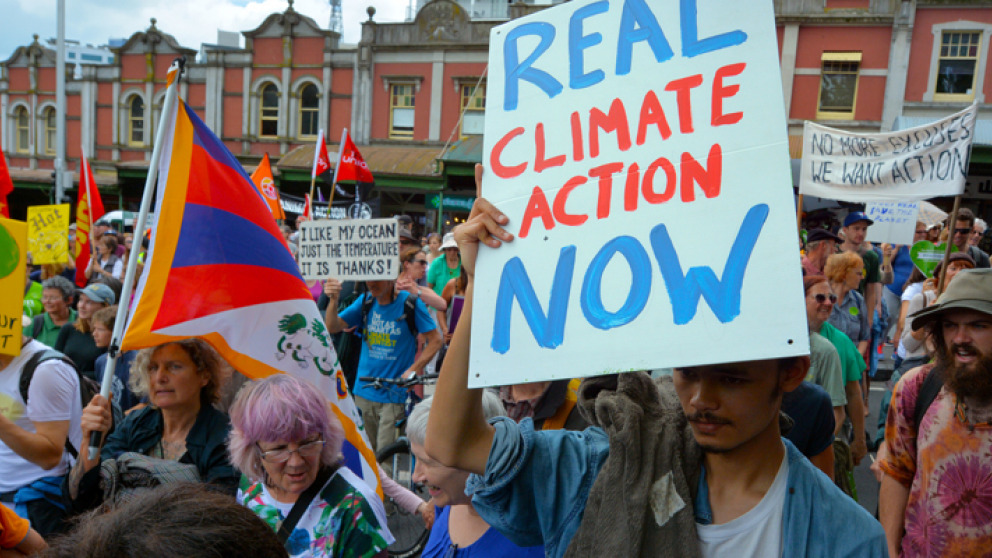20 years after the Kyoto Protocol: Are we ‘on track’ with the Paris Agreement and the COP23?
19.12.2017

On 11 December 1997, the world’s first internationally binding climate agreement was adopted: the Kyoto Protocol. It obligated 37 industrialized countries to reduce their greenhouse gas emissions individually. On average, the much celebrated agreement required a roughly 5 percent emissions reduction for industrialized countries relative to 1990. Germany even agreed to a target of 21 percent. But the hype soon gave way to reality. The United States, one of the biggest emitters, never ratified the treaty, while Canada simply stepped away from the agreement when it couldn’t reach its goals. Furthermore, new instruments such as emissions trading and the Clean Development Mechanism faced harsh criticism worldwide.
20 years later, the feelings are mixed; when it comes to climate policy, we have tackled several challenges, however, other lessons still need to be learned.
On a technical level, we have made surprising progress by constructing a new climate infrastructure.
More greenhouse gas data are now collected and analyzed than ever before. In addition to industrialized countries, more of those not required to reduce emissions under the Kyoto Protocol have begun creating national emission registries and systems for measurement, reporting, and verification (MRV) in the past few years, such as Vietnam, Chile, Costa Rica, Indonesia, Jordan, Mexico, Morocco, South Africa, and Thailand – to mention only a few. Lots of climate protection tools – some old, some new – have been tested since the Kyoto Protocol took effect. For instance, such economic tools as emissions trading systems and carbon taxes are now being used, and more countries than ever before have adopted climate protection laws and regulations. Renewables, especially solar power, are gaining ground across the planet. Last year, photovoltaics accounted for nearly two thirds of total newly installed power generation capacity.
On the other hand, global political cooperation has not kept pace.
As the many years of work needed to produce a successor to the Kyoto Protocol show, political cooperation isn’t easy. Only at the very last minute, when the Kyoto Protocol ended in 2012, did states agree to an extension in the Doha Amendment. However, it only obligated a few industrialized countries to jointly reduce emissions by at least 18 percent between 2013 and 2020 relative to 1990. And although this timeframe began in 2013, not enough members – including the EU – have ratified the agreement, so it has yet to go into force.
Then, a new agreement was reached in 2015. This time, we celebrated that the Paris Agreement had managed to include industrialized, emerging, and developing countries. But a closer look reveals that little was left of the common approach: under the Paris Agreement countries are free to set their own goals and to decide how to reach them, even though the overriding aim remains to keep global warming below 2°C.
Two years later, COP23 made it clear that technical progress is much easier to agree on than political cooperation. We know by how much greenhouse gas emissions must be reduced worldwide, but while states have agreed to a grand joint target, they have not yet agreed on a path towards that goal. All of the countries have different interpretations of the Paris Agreement and different ideas about how to reach climate protection objectives. The focus remains on national interests. Kyoto was an attempt to set limits and impose reduction approaches centrally – and that has failed. Now, every country’s sails on its own ship – but under a single Paris flag – and on its own route set forth in the “Nationally Determined Contributions” (NDCs).
There are already signs that this new approach will not take us far enough either. The latest reports show that current pledges from all Paris signatories would only lead to a third of the emission reductions needed to prevent dangerous global warming. And while the US signature on the Paris Accord was considered a historic success, it is now already to be retracted.
The “cooperative approach” is thus falling short, and the gap between industrialized and developing countries – those who have emitted the most and those who will suffer the most from climate change, respectively – remains as big as ever. At the annual UN climate conferences, national positions are collected and written up, but it’s not hard to feel like attending the conferences is more about seeing and being seen than truly learning from each other. There are contrasts and contradictions wherever you look. In one zone, representatives from around the world negotiate, while elsewhere new scientific findings are presented – along with tourism trade shows. Outside, environmental activists protest, but inside conservationists have their own booths just down the hall from nuclear energy lobbyists.
Although this “conference of contrast” has tremendous potential, I personally feel that a lot of it is left untapped. The contradictions are not discussed, perhaps because such a wide range of facets needs to be integrated. Indeed, we still have a lot to learn 20 years later.
But maybe this insight is the right starting point for change, starting small, at open-dialogue events on a wide range of topics at venues like COP.
